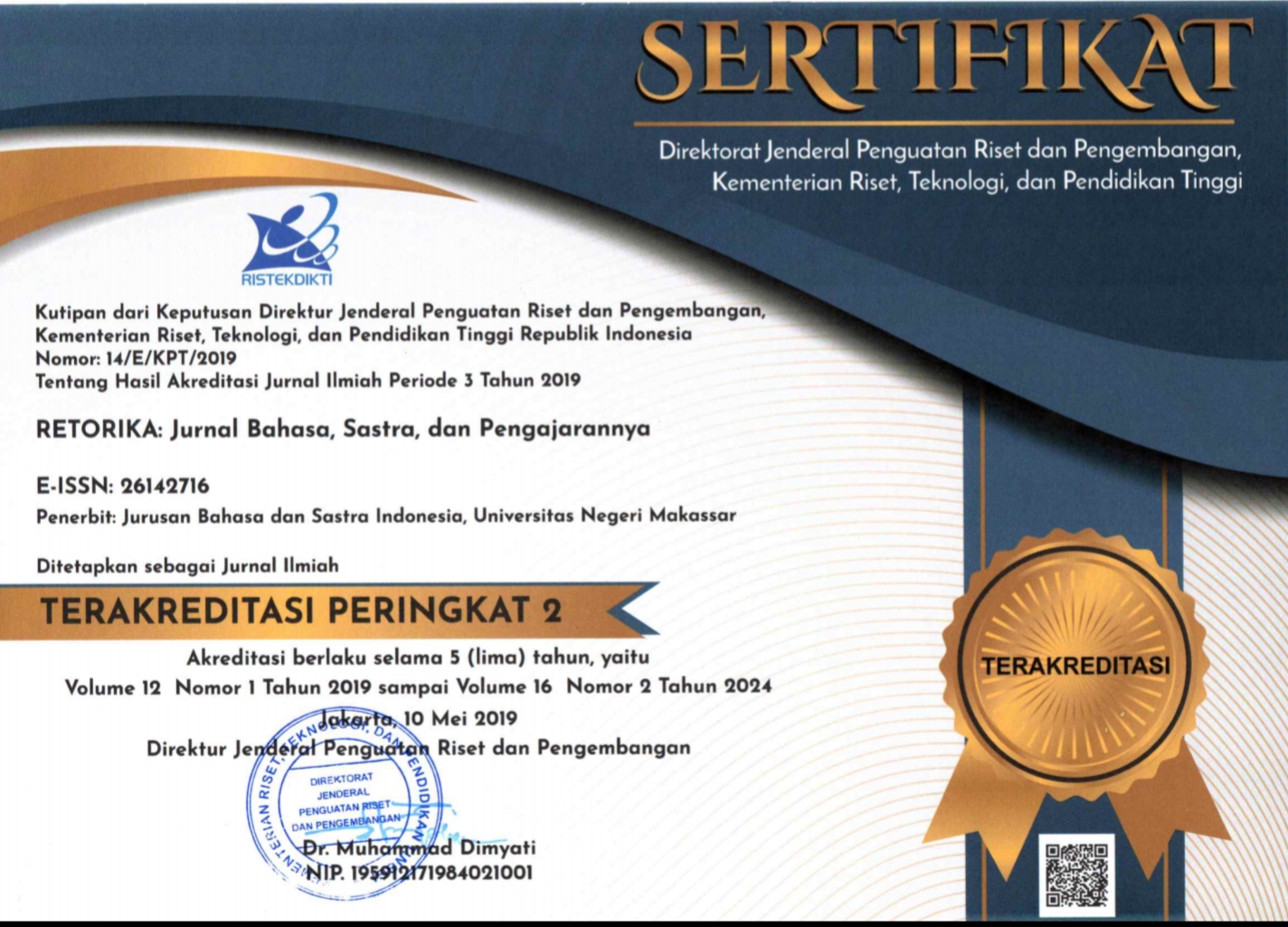COGNITIVE SEMANTICS ANALYSIS OF ANIMAL PROVERBS IN TOBA LANGUAGE
(1) Universitas HKBP Nommensen
(2) Universitas Sumatera Utara
(*) Corresponding Author
DOI: https://doi.org/10.26858/retorika.v13i2.12008
Abstract
This cognitive semantics study analyzed animal proverbs in Batak Toba language. Descriptive qualitative methods were employed in this study. Preliminary research data were collected from the Umpama and Umapasa Collection of Batak Toba languages written by Richard Sinaga. All proverbs were listened to and grouped by recording and selecting the existing data. In the analysis process, theresearchers conducted interpretation method. In addition, the researcher conducted interviews with three Toba native speakers including the researcher himself, and a Batak-Toba linguist. The results showed that there was 33 lexicon used in Toba Batak proverbs. The animal lexicon consists of mammals (46%), birds (27%), insects (14%), fish (10%), and amphibians (1%). The conceptualization of the animals is both positive and negative. The use of animal in the Toba Batak proverbs not only aims to convey ideas or ideas but can also describe the perceptions, experiences and daily life depictions of the Toba Batak people.
Keywords
Full Text:
PDFReferences
Abdullah, I. H. (2011). Analisis Kognitif Semantik Peribahasa Melayu Bersumber dari Anjing. GEMA Online Journal Of Language Studies, II (1).
Allwood, J. & Gardenfors P. (1999). Cognitive Se-mantics: Meaning and Cognition. NewYork: John Benjamins Publishing Company.
Chairani, E. (2017). Kajian Kognitif Semantik Penggunaan Anggota Tubuh dalam Peribahasa Bahasa Indonesia. Tesis. Medan: Pascasarjana Unimed
Deli, N. (2014). Proses Kognitif dalam Ungkapan Metaforis. Jurnal Parole, 4 (1).
Haula, B. & Tajudin N. (2019). Konseptualisasi Metafora dalam Rubrik Opini Kompas: Kajian Semantik Kognitif. Jurnal Retorika, 12 (1). http://ojs.unm.ac.ic/retorika/article/view/735
Howell, S. R. (2000). Metaphor, Cognitive Models, Language. Mc.Master University Honeck.
Jaszczolt, K. M. (2002). Semantics and Pragmatics: Meaning in Language and Discourse. Edin-burgh: Pearson Education.
Kinantik, K. P. (2019). Metafora Tumbuhan dalam Peribahasa Indonesia: Kajian Semantik Kogni- tif. Jurnal Belajar Bahasa, PSPBSI Univiver-sitas Muhammadiah Jember
Konvesces, Z. (2002). Methaphor: Practical Intro-duction. Newyork: Oxford University Press.
Lakoff, G. & Johnson, M. (1980). Metaphors We Live By. Chicago: The University of Chicago Press.
Lakoff, G. (1992). The Contemporary Theory of Metaphor. Cambridge: University Press.
Lyons, J. (1995). Linguistic Semantics. New York: Cambridge University Press.
Mieder, W. (2004). Proverbs: A handbook. London: Greenwood Press.
Norrick, N. R. (1985). How Proverbs Mean? Semantic Studies in English Proverbs. Amsterdam: Mouton.
Rahardian, E. (2018). Tinjauan Semantik Kognitif Terhadap Peribahasa Indonesia Bersumber dari Harimau. Makalah Disajikan dalam Semi-nar Hasil Penelitian Kebahasaan dan Kesu-sasteraan, Balai Bahasa Jawa Tengah, 22 November 2018.
Richard, P. (2013). A Proverb in Mind: The Cognitive Science of Proverbial. New Jersey London: University Of Cincinnati.
Saeed, J. I. (1997). Semantics. Malden: Blackwell Publisher Inc.
Sameer, I. H. (2016). A Cognitive Study of Certain Animals in English and Arabic Proverbs: A Comparative Study. International Journal of Language and Linguistics, 3 (5).
Sihombing, T.M. (1989). Jambar Hata Dongan Tu Ulaon Adat. Medan: Tulus Jaya
Silalahi, R. (2005). Metafora dalam Bahasa Batak Toba. Jurnal Logat, I (2).
Sinaga, R. (2013). Umpasa, Umpama, dan Ungkapan dalam Bahasa Batak Toba. Jakarta: Penerbit Dian Utama.
Siregar, B. (2004) Metaphors of Governance in the Language of the Indonesian Pers. Jakarta: Unika Atmajaya.
Sudaryanto. (2008). Metode dan Aneka Teknik Analisis Bahasa: Pengantar Penelitian Waha-na Kebudayaan Secara Linguistik. Yogyakar-ta: Duta Wacana University Press.
Tampubolon, J. F. (1998). Umpasa Batak Toba: Tinjauan Mimetic. Medan: Fakultas Sastra, Universitas Sumatera Utara
Usman, F. (2004). Metafora dalam Mantra Minang-kabau. Tesis. Denpasar: PPs Universitas Uda-yana Denpasar.
Article Metrics
Abstract view : 1305 times | PDF view : 209 timesRefbacks
Copyright (c) 2020 elza leyli saragih

This work is licensed under a Creative Commons Attribution-NonCommercial 4.0 International License.
Published by:
Department of Indonesian Language, Faculty of Languages and Literature, Universitas Negeri Makassar in cooperate with Asosiasi Dosen Bahasa dan Sastra Indonesia (ADOBSI) and Ikatan Program Studi Pendidikan Bahasa dan Sastra Indonesia (IKAPROBSI).
Address: Department of Indonesian Language Office, DG Building Second Floor, UNM Parangtambung, Daeng Tata Raya Street, Makassar, South Sulawesi, Indonesia
 Email: retorika@unm.ac.id
Email: retorika@unm.ac.id

RETORIKA: Jurnal Bahasa, Sastra,dan Pengajarannya is licensed under a Creative Commons Attribution-NonCommercial 4.0 International License.
















